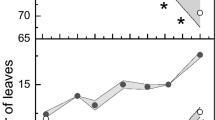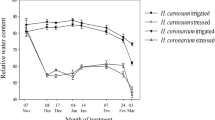Abstract
About 20-year-old desert plants of C4 species, Haloxylon ammodendron, growing at the southern edge of the Badain Jaran Desert in China, were selected to study the photosynthetic characteristics and changes in chlorophyll fluorescence when plants were subject to a normal arid environment (AE), moist atmospheric conditions during post-rain (PR), and the artificial supplement of soil water (SW). Results showed that under high radiation, in the AE, the species down-regulated its net assimilation rate (A) and maximum photochemical efficiency of PS II (Fv/Fm), indicating photoinhibition. However, under the PR and SW environments, A was up-regulated, with a unimodal diurnal course of A and a small diurnal change in Fv/Fm, suggesting no photoinhibition. When the air humidity or SW content was increased, the light compensation points were reduced; light saturation points were enhanced; while light saturated rate of CO2 assimilation (A max) and apparent quantum yield of CO2 assimilation (ΦC) increased. ΦC was higher while the A max was reduced under PR relative to the SW treatment. It was concluded that under high-radiation conditions drought stress causes photoinhibition of H. ammodendron. Increasing air humidity or soil moisture content can reduce photoinhibition and increase the efficiency of solar energy use.





Similar content being viewed by others
Abbreviations
- A :
-
Net assimilation rate
- A max :
-
Light saturated rate of CO2 assimilation
- AE:
-
Arid environment
- ΦC :
-
Apparent quantum yield of CO2 assimilation
- Ca :
-
Ambient CO2 concentration
- Ci :
-
Intercellular CO2 concentration
- Fv/Fm:
-
Maximum photochemical efficiency of PS II
- I c :
-
Light compensation point
- I k :
-
Light saturation point
- PR:
-
Moist atmospheric conditions during post-rain
- PFD:
-
Photon flux density
- RH:
-
Air relative humidity
- SW:
-
Supplement of soil water
- SW1:
-
On day 1 after watering
- SW2:
-
On day 2 after watering
- Ta:
-
Air temperature
- Tl:
-
Leaf temperature
References
Anderson JM, Park YI, Chow WS (1997) Photoinactivation and photoprotection of photosystem II in nature. Physiol Plant 100:214–223
Björkman O, Demmig B (1987) Photon yield of O2 evolution and chlorophyll fluorescence characteristics at 77 K among vascular plants of diverse origins. Planta 170:489–504
Choudhury NK, Behera RK (2001) Photoinhibition of photosynthesis: role of carotenoids in photoprotection of chloroplast constituents. Photosynthetica 39:481–488
Demmig-Adams B, Adams WW (1992) Photoprotection and other response of plants to high light stress. Ann Rev Plant Physiol Plant Mol Biol 43:599–626
Edwards GE, Baker NR (1993) Can CO2 assimilation in maize leaves be predicted accurately from chlorophyll fluorescence analysis? Photosynth Res 37:89–102
Farquhar GD, Sharkey TD (1982) Stomatal conductance and photosynthesis. Ann Rev Plant Physiol 33:317–345
Figueroa ME, Fernandez-Baco L, Luque T, Davy AJ (1997) Chlorophyll fluorescence, stress and survival in populations of mediterranean grassland species. J Veg Sci 8:881–888
Flexas J, Escalona JM, Medrano H (1999) Water stress induces different levels of photosynthesis and electron transport rate regulation in grapevines. Plant Cell Environ 22:39–48
Franco AC, Lüttge U (2002) Midday depression in savanna trees: coordinated adjustments in photochemical efficiency, photorespiration, CO2 assimilation and water use efficiency. Oecologia 131:356–365
Jia HS, Lu CM (2003) Effects of abscisic acid on photoinhibition in maize plants. Plant Sci 165:1403–1410
Johnson GN, Young AJ, Scholes JD, Horton P (1993) The dissipation of excess excitation energy in british plant species. Plant Cell Environ 16:673–679
Ju Q, Gong L, Yan GL, Pan XL (2005) Interrelation between the process of photosynthetic physiological ecology of Haloxylon ammodendron and xeric environment. J Arid Land Resour Environ 19:201–204
Krause GH, Weis E (1991) Chlorophyll fluorescence and photosynthesis: the basics. Annu Rev Plant Physiol Plant Mol Biol 42:313–349
Lawlor DW, Cornic G (2002) Photosynthetic carbon assimilation and associated metabolism in relation to water deficits in higher plants. Plant Cell Environ 25:275–294
Long SP, Humphries S, Falkowski PG (1994) Photoinhibition of photosynthesis in nature. Annu Rev Plant Physiol Plant Mol Biol 45:633–662
Ludlow MM (1976) Ecophysiology of C4 grasses. In: Lange OL, Kappen L, Schulze ED (eds) Water and plant life: problems and modern approaches. Springer, Berlin, Heidelberg, New York, pp 364–386
Odasz-Albrigtsen AM, Tømmervik H, Murphy P (2000) Decreased photosynthetic efficiency in plant species exposed to multiple airborne pollutants along the Russian-Norwegian border. Can J Bot 78:1021–1033
Öquist G, Chow WS, Anderson JM (1992) Photoinhibition of photosynthesis represents a mechanism for the long-term regulation of photosystem II. Planta 186:450–460
Osmond CB, Grace SC (1995) Perspectives on photoinhibition and photorespiration in the field: quintessential inefficiencies of the light and dark reaction of photosynthesis? J Exp Bot 46:1351–1362
Powles SB (1984) Photoinhibition of photosynthesis induced by visible light. Annu Rev Plant Physiol 35:15–44
Sassenrath GF, Ort DR (1990) The relationship between inhibition of photosynthesis at low temperature and the inhibition of photosynthesis after rewarming in chillsensitive tomato. Plant Physiol Biochem 28:457–465
Schreiber U, Bilger W, Neubauer C (1994) Chlorophyll fluorescence as a nonintrusive indicator for rapid assessment of in vivo photosynthesis. In: Schulze ED, Caldwell MM (eds) Ecophysiology of photosynthesis. Springer, Berlin, Heidelberg, New York, pp 49–70
Schulze ED (1986) Carbon dioxide and water vapor response to drought in the atmosphere and in the soil. Annu Rev Plant Physiol 37:247–274
Seppänen MM, Coleman GD (2003) Characterization of genotypic variation in stress gene expression and photosynthetic parameters in potato. Plant Cell Environ 26:401–410
Solhaug KA, Haugen J (1998) Seasonal variation of photoinhibition of photosynthesis in bark from Populus tremula L. Photosynthetica 35:411–417
Su PX, Liu XM (2005) Photosynthetic characteristics of linze jujube in conditions of high temperature and irradiation. Sci Hortic 104:339–350
Su PX, Liu XM, Zhang LX, Zhao AF, Li WR, Chen HS (2004) Comparison of δ13C values and gas exchange of assimilating shoots of desert plants Haloxylon ammodendron and Calligonum mongolicum with other plants. Isr J Plant Sci 52:87–97
Tezara W, Marín O, Rengifo E, Martínez D, Herrera A (2005) Phtosynthesis and photoinhibition in two xerophytic shrubs during drought. Photosynthetica 43:37–45
Von Caemmerer S, Farquhar GD (1981) Some relationships between the biochemistry of photosynthesis and the gas exchange of leaves. Planta 153:376–387
Werner C, Correia O, Beyschlag W (1999) Two different strategies of mediterranean macchia plants to avoid photoinhibitory damage by excessive radiation levels during summer drought. Acta Oecologica 20:15–23
Zhao CM, Wei XP, Yu QS, Deng JM, Cheng DL, Wang GX (2005) Photosynthetic characteristics of Nitraria tangutorum and Haloxylon ammodendron in the ecotone between oasis and desert in Minqin Region, northwest China. Acta Econ Sin 25:1908–1923
Acknowledgements
We are grateful for the financial support by the National Natural Sciences Foundation of China (No. 40471046) and the key project of the Chinese Academy of Sciences (KZCX1-09). The authors also want to express thanks to the editor and the anonymous reviewers for their valuable comments to the manuscript.
Author information
Authors and Affiliations
Corresponding author
Rights and permissions
About this article
Cite this article
Su, P., Cheng, G., Yan, Q. et al. Photosynthetic regulation of C4 desert plant Haloxylon ammodendron under drought stress. Plant Growth Regul 51, 139–147 (2007). https://doi.org/10.1007/s10725-006-9156-9
Received:
Accepted:
Published:
Issue Date:
DOI: https://doi.org/10.1007/s10725-006-9156-9




